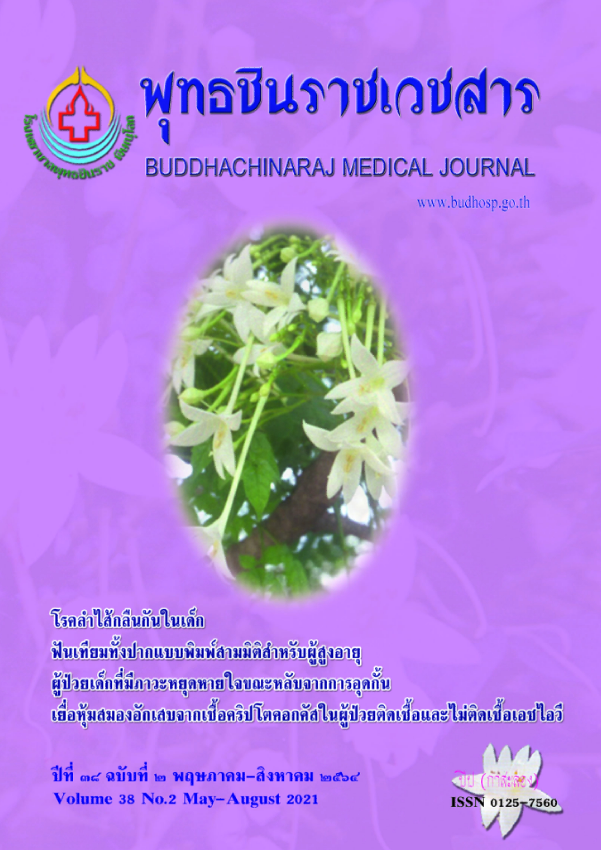ผลการรักษาผู้ป่วยปวดคอจากกล้ามเนื้อคอหดเกร็งระหว่างวิธีกายภาพบำบัดร่วมกับ การบริหารคอแบบจำเพาะเจาะจงและวิธีกายภาพบำบัด
ผลการรักษาผู้ป่วยปวดคอจากกล้ามเนื้อคอแข็งเกร็ง
คำสำคัญ:
อาการปวดคอ, ภาวะกล้ามเนื้อคอแข็งเกร็ง, การบริหารคอแบบจำเพาะเจาะจง, การรักษา ทางกายภาพบำบัดบทคัดย่อ
อาการปวดคอจากกล้ามเนื้อคอแข็งเกร็งพบเป็นอันดับแรกของผู้ป่วยที่มารับบริการกายภาพบำบัด การทดลองครั้งนี้มีวัตถุประสงค์เพื่อเปรียบเทียบผลการรักษาผู้ป่วยปวดคอจากกล้ามเนื้อคอแข็งเกร็งระหว่างวิธีกายภาพบำบัดร่วมกับการบริหารคอแบบจำเพาะเจาะจง (กลุ่มที่ 1) และวิธีกายภาพบำบัดอย่างเดียว (กลุ่มที่ 2) ศึกษาในผู้ป่วยปวดคอจากกล้ามเนื้อคอแข็งเกร็งที่มารับการรักษาที่งานกายภาพบำบัด โรงพยาบาลพุทธชินราช พิษณุโลก ระหว่างเดือนตุลาคม พ.ศ. 2563 ถึงเดือนมิถุนายน พ.ศ. 2564 โดยจับสลากแบ่งผู้ป่วยเป็น 2 กลุ่ม กลุ่มละ 29 คน เปรียบเทียบ ข้อมูลระหว่างผู้ป่วยทั้งสองกลุ่มด้วยสถิติ chi-square, chi-square for linear trend, Mann Whitney U และ Wilcoxon signed rank กำหนดระดับนัยสำคัญทางสถิติที่ 0.05 ผลการศึกษาพบว่าเพศ อายุ อาชีพ ระดับการศึกษา อาการแสดง คะแนนความปวด และคะแนนภาวะทุพพลภาพ ก่อนรักษาของผู้ป่วยทั้งสองกลุ่มไม่แตกต่างกัน คะแนนความปวดและคะแนนภาวะทุพพลภาพที่ลดลงหลังรักษาของทั้งสองกลุ่มแตกต่างกันอย่างมีนัยสำคัญทางสถิติ โดยคะแนนความปวดและคะแนนภาวะทุพพลภาพที่ลดลงหลังรักษาของกลุ่มที่ 1 ลดลงมากกว่ากลุ่มที่ 2 ทั้งนี้ ไม่มีผู้ที่ต้องยุติการศึกษา สรุปได้ว่าวิธีกายภาพบำบัดร่วมกับการบริหารคอแบบจำเพาะเจาะจงลดอาการปวดคอจากกล้ามเนื้อคอแข็งเกร็งได้ดีกว่าวิธีกายภาพบำบัดอย่างเดียว
เอกสารอ้างอิง
2. Kent PM, Keating JL.The epidemiology of low back pain in primary care. Chiropr Osteopat 2005;13:13. doi: 10.1186/1746-1340-13-13
3. Zoer I, Frings-Dresen MH, Sluiter JK. Are musculoskeletal complaints, related work impairment and desirable adjustments in work age-specific?. Int Arch Occup Environ Health 2014;87(6):647-54.
4. Rachlin ES, Rachlin IS. Myofascial pain and fibromyalgia trigger point managements. 2nd ed. St Louis, Missouri State, USA: Mosby;2002.
5. Hoy D, Bain C, Williams G, March L, Brooks P, Blyth F, et al. A systematic review of the global prevalence of low back pain. Arthritis Rheum 2012;64(6):2028-37.
6. Oha K, Animagi L, Paasuke M, Coggon D, Merisalu E. Individual and work-related risk factors for musculoskeletal paina cross-sectional study among Estonian computer users. BMC Musculoskelet Disord 2014;15:181. doi: 10.1186/1471-2474-15-181
7. Paksaichol A, Janwantanakul P, Purepong N, Pensri P. Office workers' risk factors for the development of non-specific neck pain: a systematic review of prospective cohort studies. Occup Environ Med 2012;69(9):610-8.
8. Janwantanakul P, Pensri P, Jiamjarasrangsri V, Sinsongsook T. Prevalence of selfreported musculoskeletal symptoms among office workers. Occup Med (Lond) 2008;58(6):436-8.
9. Lotters F, Meerding WJ, Burdorf A. Reduced productivity after sickness absence due to musculoskeletal disorders and its relation to health outcomes. Scand J Work Environ Health 2005;31(5):367-74.
10. Pensri P, Foster NE, Srisuk S, Baxter GD, McDonugh SM. Physiotherapy management of low back pain in Thailand: a study of practice. Physiother Res Int 2005;10(4):201-12.
11. Gam AN, Warming S, Larsen LH, Jensen B, Hoydalsmo O, Allon I, et al. Treatment of myofascial trigger-points with ultrasound combined with massage and exercise-a randomized controlled trial. Pain 1998;77(1):73-9. doi: 10.1016/S0304-3559(98)00084-0
12. Majlesi J, Unalan H. High power pain threshold ultrasound technique in the treatment of active myofascial trigger points: a randomized, double blind, case control study. Arch Phys Med Rehabil 2004;85(5):833-6.
13. Hecox B, Mehreteab TA, Weisberg J. Physical agents: a comprehensive text for physical therapists. Norwalk, Connecticut State, USA: Appleton & Lange; 1994. p.163-91.
14. Martin BI, Deyo RA, Mirza S, Turner JA, Comstock B, Hollingworth W, et al. Expenditures and health status among adults with back and neck problems. JAMA 2008;299(6):656-64.
15. Cote P, van der Velde G, Cassidy JD, Carroll LJ, Hogg-Jonhson S, Holm LW, et al. The burden and determinants of neck pain in workers; results of the bone and joint decade 2000-2010 task force on neck pain and its associated disorders. JMPT 2009;32(2 Suppl):S70-86.
16. Hush JM, Michaleff Z, Maher CG, Refshauge K. Individual, physical and psychological risk factors for neck pain in Australian office workers: a 1-year longitudinal study. Eur Spine J 2009;18(10):1532-40.
17. Buddhachinaraj Phitsanulok Hospital. Annual-reports [cited 2021 Jul 15]. Available from: URL: http://192.168.50.58/Budhosp App Center/annual-reports/2562
18. Simon DG, Travell JG. Myofascial pain and dysfunction: the trigger point manual. Vol. 1. upper half of body. 2nd ed. Baltimore, Maryland State, USA: Williams and Wilkins;1999.
19. Palaviwat K. Electrotherapeutic equipments for physical therapy. Bangkok, Thailand: The Books Publishing; 2000. p.260-343.
20. Janwantanakul P, Pensri P, Jiamjarasrangsi W, Sinsongsook T. Prevalence, contributors and economic loss of work-related musculoskeletal symptoms among office workers in company in Bangkok Metropolis area. Bangkok, Thailand: Research and Development Division, The Social Security Officer;2005.
21. Bijur PE, Latimer CT, Callagher EJ. Validation of a verbally administered numerical rating scale of acute pain for use in the emergency department. Acad Emerg Med 2003;10(4):390-2.
22. Bendinger T, Plunkett N. Measurement in pain medicine. BJA Educ 2016;16(9): 310-5.
23. Vernon H, Mior S. The Neck Disability Index: a study of reliability and validity. JMPT 1991;14(7):409-15.
24. Ngamjarus C, Chongsuvivatwong V. N4Studies: sample size and power calculations for IOS [online]. 2014 [cited 2019 June 12]. Available from: URL: https://apps.apple.com/th/app/n4studies/id680516901
25. Korhonen T, Ketola R, Toivonen R, Luukkonen R, Hakkanen M, Viikari-Juntura E. Work related and individual predictors for incident neck pain among office employees working with video display units. Occup Environ Med 2003l;60(7):475-82.
26. Ming Z, Narhi M, Siivola J. Neck and shoulder pain related to computer use. Pathophysiology 2004;11(1):51-6.
27. Wilson A. Ergonomicfactors. Effective management of musculoskeletal injury: a clinical ergonomics approach to prevention, treatment and rehabilitation. Edinburgh, United Kingdom: Churchill Livingstone; 2001.
28. Wahlstrom J, Hagberg M, Toomingas A, Tornqvist EW. Perceived muscular tension, job strain, physical exposure, and associations with neck pain among VDU users; a prospective cohort study. Occup Environ Med 2004;61(6):523-8.
29. Wannapira W, Wannapira P. Prevalence and factors associated with neck and shoulder pain among hospital personnel. Buddhachinaraj Med J 2008;25(1):34-41.
30. Walker MJ. The effectiveness of manual physical therapy and exercise for mechanical neck pain: a randomized clinical trial. Spine 2008;33(22):2371-8.
31. Kaka B, Ogwumike OO, Adeniyi AF, Maharaj SS, Ogunlade SO, Bello B. Effectiveness of neck stabilization and dynamic exercises on pain intensity, depression and anxiety among patients with non-specific neck pain: a randomised controlled trial. Scand J Pain 2018;18(2):321-31.
32. Buyukturan O, Buyukturan B, Sas S, Karati C, Ceylan I. The effect of Mulligan mobilization technique in older adults with neck pain: a randomized controlled, double-blind study. Pain Res Manag 2018;2018:2856375.doi: 10.1155/2018/2856375
33. Picavate HSJ, Schouten JSAG. Musculoskeletal pain in the Netherlands: prevalences, consequences and risk groups, the DMC3- study. Pain 2003;102(1-2):167-78.
34. Nolet PS, Cote P, Kristman VL, Rezai M, Carroll LJ, Cassidy JD. Is neck pain associated with worse health-related quality of life 6 months later? a populationbased cohort study. Spine J 2015;15(4):675-84.
35. Leroux I, Dionne CE, Bourbonnais R, Brisson C. Prevalence of musculoskeletal pain and associated factors in the Quebec working population. Int Arch Occup Environ Health 2005;78(5):379-86.






